Ever wondered why some buildings need special steel while others don’t? This guide will show you the different steel types, what they’re made of, and where they’re used. Steel isn’t just iron and carbon mixed together. It’s a complex mix of elements and grades, leading to over 3,500 types. Knowing about steel can make a big difference in how well a project works.
Let’s explore the world of steel together. We’ll learn how to pick the right materials for our work.
Key Takeaways
- Understanding steel types is essential for effective project planning and execution.
- Steel compositions greatly impact the performance characteristics of materials.
- Choosing the right steel can lead to significant improvements in durability and efficiency.
- Over 3,500 variations of steel offer a range of applications in engineering.
- Light gauge steel plays a key role in modern building methods.
- Tool steel is made for the toughness needed in making tools.
Introduction to Steel
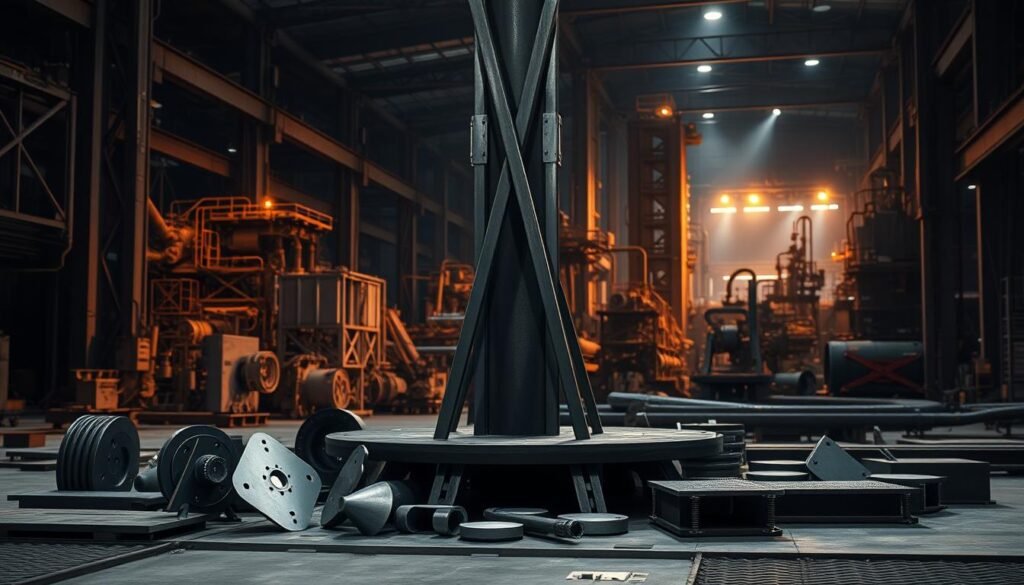
Steel is a key part of our modern world, supporting many industries with its strength and flexibility. In this introduction, we explore the steel basics, including its makeup and types. Understanding steel material properties helps us see its importance in building and making things.
Steel is mostly iron and carbon, with other elements to make it better for certain uses. Different alloys give steel unique traits, making it perfect for many tasks. This shows how steel has grown, becoming vital in engineering and daily life.
Steel’s benefits are clear:
- High tensile strength
- Durability in many conditions
- Resistance to bending
- It can be recycled, helping the environment
Learning about steel types and uses helps us choose the right materials. This knowledge ensures we pick the best materials for our projects, based on their steel material properties.
The Importance of Steel in Construction and Manufacturing
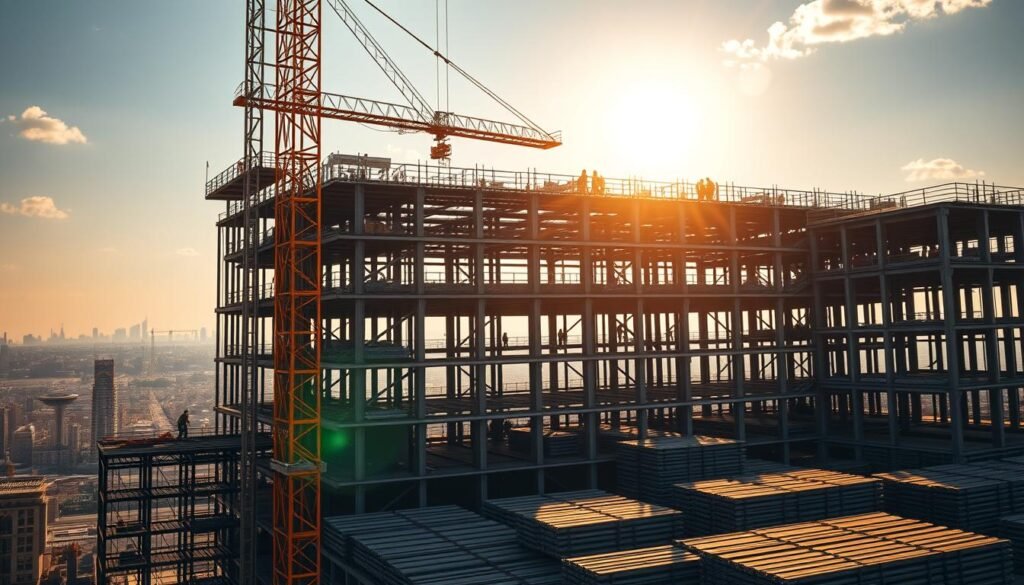
Steel is key in construction and manufacturing. It’s strong, durable, and versatile. This makes it essential for building everything from tall skyscrapers to strong bridges.
Steel helps create safe and lasting structures in construction. In manufacturing, it makes machines and tools more efficient. This boosts productivity and reliability.
Steel’s role is vital in our world. Without it, many modern conveniences wouldn’t exist. It’s essential for creating our environments and advancing technology.
Understanding Steel Composition

Steel is a remarkable material with a steel composition that affects its physical properties and usability. At its core, steel is made of iron and carbon. These elements give steel its strength and durability. But, adding alloying elements like chromium, nickel, and molybdenum changes its properties. This leads to a wide range of steel grades for different uses.
Knowing about these components helps us see how alloying elements improve or change steel’s hardness and resistance to corrosion. The mix of carbon and other elements decides if steel is good for building, cars, or making things.
| Element | Function | Effect on Steel |
|---|---|---|
| Iron | Base element | Provides strength; forms the backbone of steel |
| Carbon | Strength enhancer | Increases hardness; affects ductility |
| Chromium | Corrosion resistance | Enhances durability; commonly used in stainless steel |
| Nickel | Toughness | Improves impact strength and ductility |
| Molybdenum | Heat resistance | Enhances hardness at high temperatures |
Steel Classification: An Overview
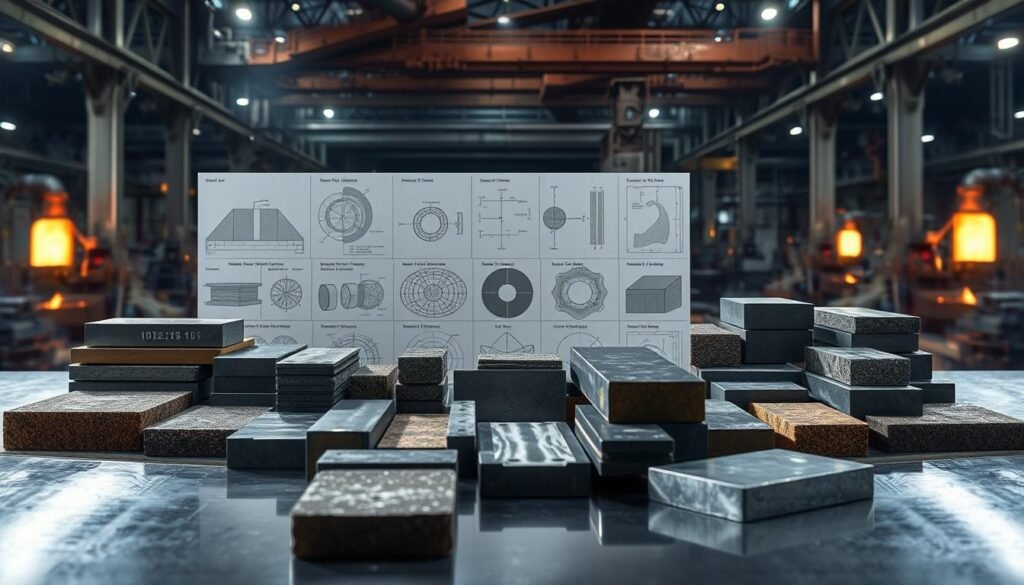
Steel classification is key to understanding different types of steel classification. It looks at the steel’s makeup and how it’s made. We mainly see carbon steel, alloy steel, and stainless steel, each with its own mix.
How steel is made also matters. For example, hot-rolled and cold-rolled methods change its properties. Cold-rolled steel often has a better finish and is more precise than hot-rolled.
Let’s look at the main types of steel classification and what they’re used for:
- Carbon Steel: It’s divided by carbon content. Low, medium, and high carbon steel vary in strength and flexibility.
- Alloy Steel: It has extra elements that make it tougher and more resistant to corrosion.
- Stainless Steel: Known for fighting off corrosion, it’s great for kitchen items and medical tools.
By knowing these classifications, we can pick the best steel for our projects. This knowledge helps us make smart choices in engineering and manufacturing.
Types of Steel: An In-Depth Look
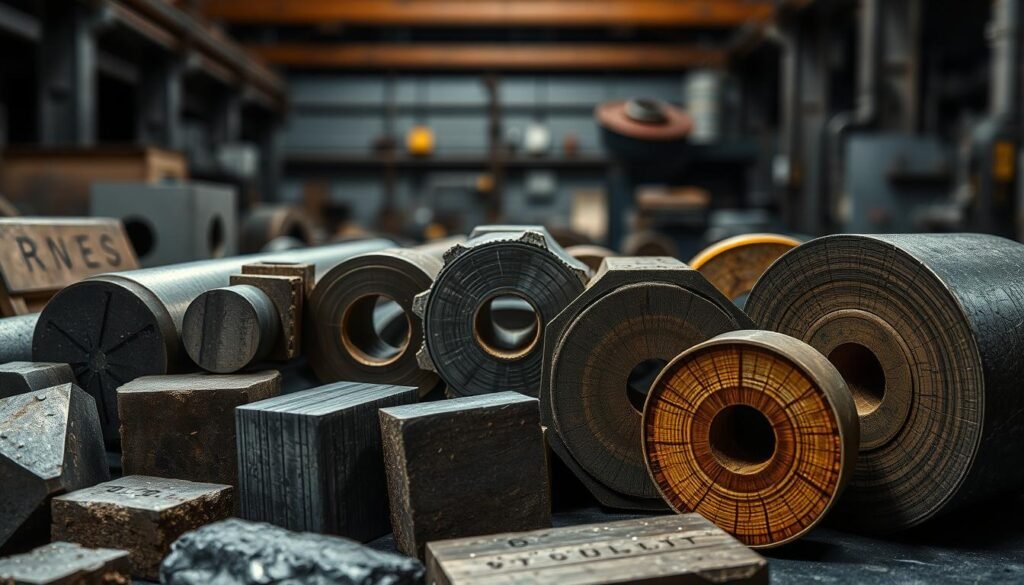
Understanding the different types of steel is key in metallurgy. We see four main types: carbon, alloy, stainless, and tool steel. Each has its own set of properties and uses, important for those who need to make smart choices. This analysis will explore the unique features of these steels and their roles in various industries.
Carbon steel is known for its strength and versatility. It comes in low, medium, and high carbon types, each suited for different uses. Low carbon steel is very ductile, great for car parts. Medium carbon steel is tough and hard, perfect for making machines.
Alloy steel adds elements to boost strength and fight corrosion. It’s customizable for construction to aerospace, where special needs exist. Adding chromium and nickel makes the steel last longer.
Stainless steel is famous for resisting corrosion. It’s used where things need to last long and stay clean. It’s divided into austenitic, ferritic, and martensitic types. Each type has its own job, from kitchen tools to building parts.
Tool steel is hard and keeps its shape under stress. It’s vital for making tools and cutting tools. There are specific grades for different tasks, ensuring the right mix of toughness and wear resistance.
| Type of Steel | Key Properties | Common Applications |
|---|---|---|
| Carbon Steel | High strength, ductility | Automotive parts, machinery |
| Alloy Steel | Enhanced strength, unique properties | Construction, aerospace |
| Stainless Steel | Corrosion resistance, durability | Kitchen equipment, structural elements |
| Tool Steel | Hardness, wear resistance | Tool manufacturing, cutting equipment |
Carbon Steels: Properties and Applications
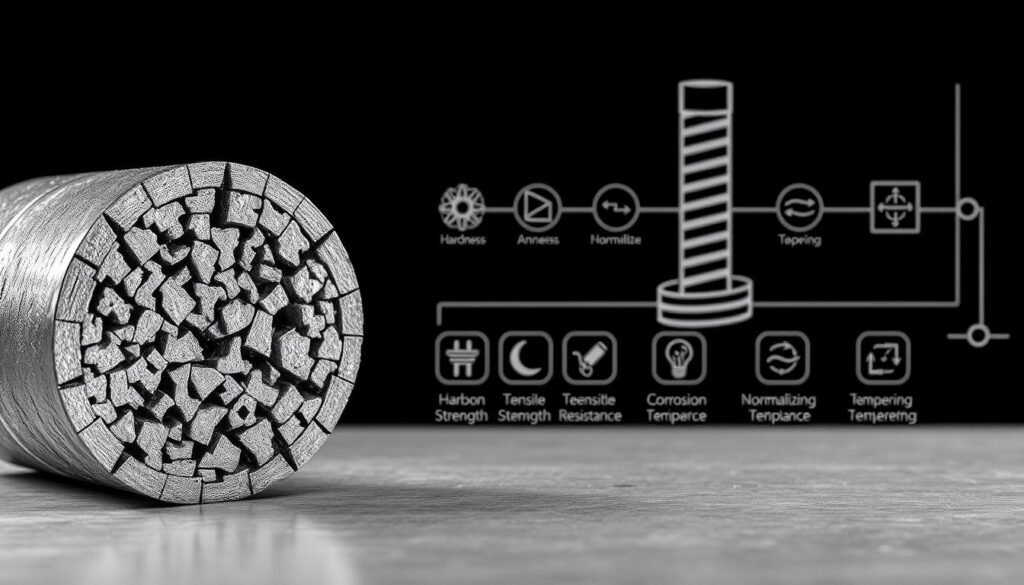
Knowing about carbon steel is key for any engineering project. It comes in low, medium, and high types, each for different uses. Each type has special properties that fit certain needs. Let’s look at each category of carbon steels.
Low Carbon Steel
Low carbon steel, also known as mild steel, has less than 0.3% carbon. It’s very ductile, making it easy to shape and weld. It’s used for:
- Automobile body panels
- Structural beams
- Pipes and tubing
- Machinery components
Its great weldability and formability make it a top choice for many projects.
Medium Carbon Steel
Medium carbon steel has 0.3% to 0.6% carbon. It’s strong but also flexible. It’s often found in:
- Automotive parts
- Railway tracks
- Dam equipment
- Heavy machinery frames
Its mix of strength and flexibility is perfect for heavy-duty tasks.
High Carbon Steel
High carbon steel has 0.6% to 1.4% carbon. It’s made for maximum hardness and strength. It’s great for:
- Cutting tools
- Blades and springs
- High-stress applications
- Wire and cables
Alloy Steels: Enhancing Properties Through Composition
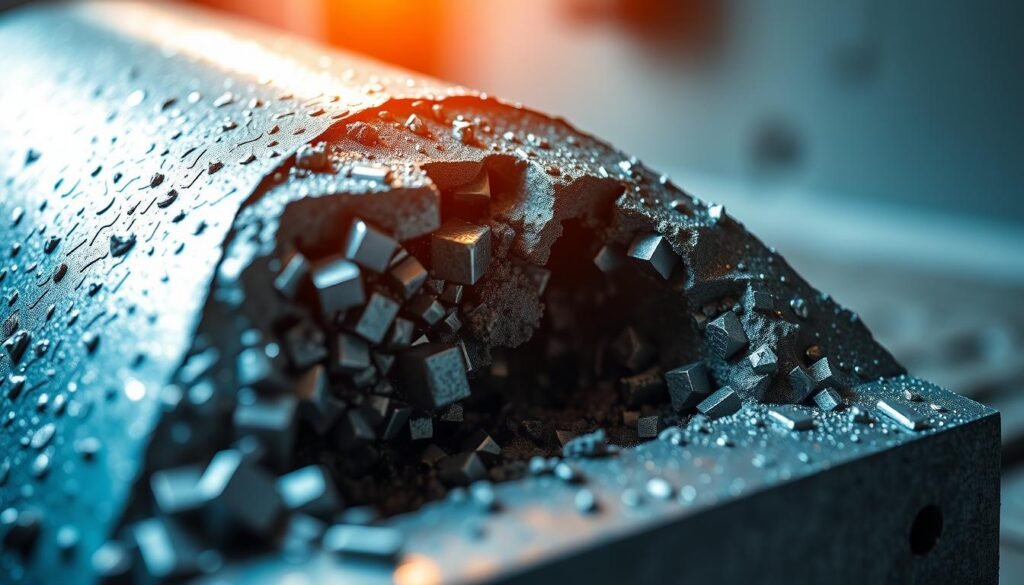
Alloy steels are known for their great strength and versatility. This is thanks to the use of alloying elements like chromium, nickel, and molybdenum. These alloying elements are added to regular carbon steel to change its properties for certain uses. Exploring alloy steel properties shows how these changes can improve performance in tough situations.
One key benefit of alloy steel is its better resistance to wear and corrosion. In fields where materials are worn down a lot, like construction and manufacturing, these elements offer big advantages. Alloy steels are not only stronger but also tougher, making them great for parts that need to last long.
Some common alloying elements include:
- Chromium – Increases hardness and strength while improving corrosion resistance.
- Nickel – Enhances toughness and impact strength, even at low temperatures.
- Molybdenum – Improves wear resistance and keeps strength at high temperatures.
By changing the steel’s composition with these elements, we can make it fit specific needs. This customization in alloy steel properties offers amazing flexibility. It helps meet the high standards of today’s projects.
Stainless Steels: Corrosion Resistance and Its Benefits
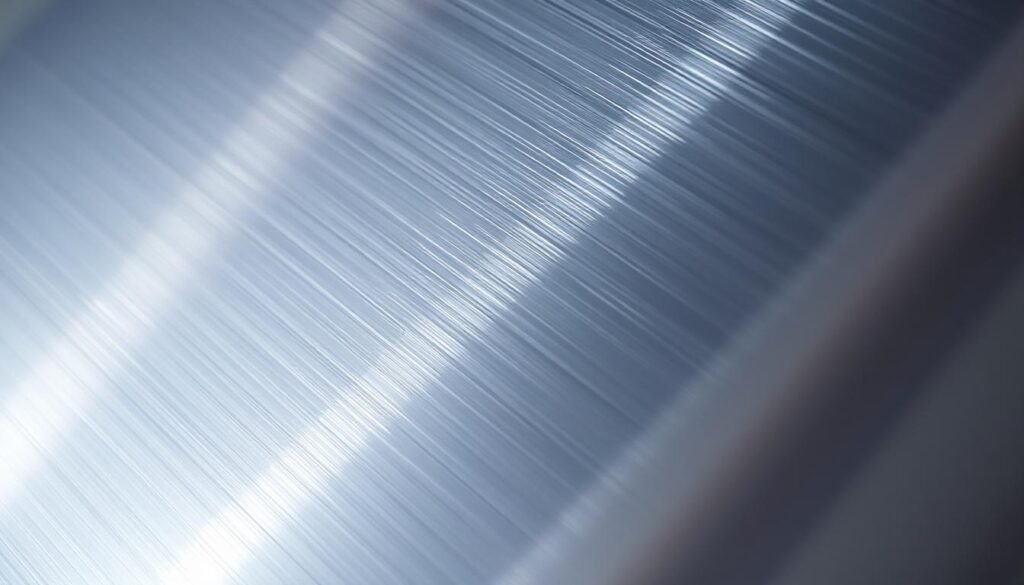
Stainless steels are known for their corrosion resistance. This is mainly because of chromium, which creates a protective layer. This layer makes stainless steel not just strong but also durable in tough conditions.
Adding elements like nickel and molybdenum makes these materials even better. This mix helps stainless steel work well in many fields. It’s used in everything from kitchen tools to building parts, meeting different needs.
In places where moisture and corrosive substances are common, like near the sea or in chemical plants, stainless steel lasts long. Using this material shows a dedication to the environment. It means we don’t have to replace things as often.
Tool Steels: Designed for Manufacturing Tools
Tool steels are key in metallurgy, made for making tools. They are hard, shock-resistant, and can handle high temperatures. This makes them vital in many industries. Let’s explore the different types of tool steel and where they’re used, showing their importance in today’s manufacturing.
Common Grades of Tool Steel
| Grade | Composition | Properties | Typical Usage |
|---|---|---|---|
| D2 | High carbon, high chromium | Excellent wear resistance, high hardness | Dies, shear blades |
| M2 | Tungsten-molybdenum | High hot hardness | Cutting tools, drill bits |
| A2 | Air-hardening alloy | Good toughness, dimensional stability | Molds, forming tools |
Applications of Tool Steel
Tool steel has many uses, showing how it combines function and creativity. It’s used in:
- Cutting tools: Needed for precise work, like drills, end mills, and saw blades.
- Molds and dies: Important for shaping materials, key in car and plane making.
- Hand tools: Tools like wrenches, pliers, and chisels need to be strong and durable.
Light Gauge Steel: Applications in Lightweight Framing
Light gauge steel is becoming more popular in building today. It’s strong but lighter than old materials. This makes it great for many uses in homes and businesses.
For homes, builders use it to make buildings that are both strong and easy to build. It works well for walls, roofs, and floors. For bigger buildings like offices, it helps them stand strong without losing design freedom.
Using light gauge steel in building has many benefits:
- Reduction in labor costs because it’s easier to install and faster to put together.
- Energy efficiency improves, helping to cut down on heating and cooling costs.
- Resilience against natural disasters, like earthquakes, because it’s lighter and puts less stress on buildings.
Knowing about light gauge steel helps builders choose the best materials for today’s buildings. Using it leads to new designs and helps the environment.
The Complete Guide to Steel Types: From Light Gauge to Tool Steel
We’ve explored the wide world of steel types, each with its own special traits and uses. This detailed look at steel shows how different they are and why knowing these differences matters. From alloy steels to carbon steels, each type has its own set of features that make it useful in different fields.
Understanding these steel types is key for professionals. It helps them choose the right materials for their projects. With our guide, engineers, architects, and manufacturers can pick the best steel for their needs. This ensures their projects run smoothly and efficiently.
Steel Properties: Strength, Ductility, and Hardness
Understanding steel’s mechanical properties is key. This includes its strength, ductility, and hardness. Each property affects how well steel performs in different situations.
The strength of steel means it can handle forces without breaking. This is important for structures that need to be strong and safe. Steel with high strength can carry heavier loads, making it great for building and making things.
Ductility lets steel stretch when stressed, preventing sudden breaks. This helps steel absorb energy, making structures more stable. The ductility of steel changes based on its mix and treatment, affecting its use.
Lastly, hardness in steel shows how well it resists wear and scratches. Harder steels are used in tools and machines where wear is a big issue. By changing the heat treatment and mix, steel can be made harder for specific jobs.
| Property | Description | Applications |
|---|---|---|
| Strength of Steel | Resistance to deformation and breaking under stress | Construction, bridges, high-rise buildings |
| Ductility | Ability to deform without fracture | Seismic structures, automotive components |
| Hardness in Steel | Resistance to wear and indentation | Cutting tools, industrial machinery |
Production Processes: Hot-Rolled and Cold-Rolled Steel
Steel production methods shape its properties and uses. Hot-rolled and cold-rolled steel are two main types. Each meets different needs in engineering and building.
Hot-rolled steel is made by rolling it at high temperatures. This makes it easier to shape. It’s often used in structures like beams and rail tracks. It’s also cheaper to make because of the fast process.
Cold-rolled steel is processed at room temperature after being hot-rolled. This improves its finish and accuracy. It’s used for parts needing tight fits, like car parts and consumer goods. This precision comes at a higher cost, showing its specialized use.
| Property | Hot-Rolled Steel | Cold-Rolled Steel |
|---|---|---|
| Temperature During Processing | High Temperature | Room Temperature |
| Surface Finish | Rough | Smooth |
| Tolerances | Less Precise | Highly Precise |
| Cost | Lower | Higher |
| Typical Applications | Structural Components | Automotive Parts |
Knowing how steel is made helps choose the right material for a project. The choice between hot-rolled and cold-rolled steel affects both function and cost in engineering.
Heat Treatment Methods: Improving Steel Properties
Heat treatment of steel is key to making it stronger. Methods like annealing, quenching, and tempering are used to get the best results. Each method changes the steel’s structure, boosting its strength, toughness, and hardness.
Annealing heats steel to a certain point and then cools it slowly. This process relieves stress and makes the grain structure finer. It improves the steel’s ability to bend and be machined. It’s great for steels that have been hardened, as it brings back some of their lost toughness.
Quenching quickly cools heated steel in water or oil. This makes the steel very hard. But, it can also make it brittle. To fix this, tempering is done by heating the steel again to a lower temperature. This balances the steel’s hardness and toughness, making it perfect for applications that need resilience.
Knowing about these heat treatment methods is vital for improving steel properties. It lets engineers make steel fit for different uses. As we dive deeper, we see how proper heat treatment boosts performance and durability. This is essential in many fields, from building to making things.
Choosing the Right Steel Type for Your Project
Choosing the right steel is key for any project. We start by knowing what our project needs. This includes how much weight it can hold, the weather, and our budget. Each project is different, so we look at various steel types to find the best fit.
When picking steel, we think about the loads it will face. For example, high carbon steel is strong for heavy tasks. Stainless steel is good for places where things rust a lot. The right steel also depends on how it will last and how easy it is to maintain.
It helps to plan carefully. We list what our project needs most, putting the most important first. Getting advice from experts and using real data helps make sure our choices are smart. This careful thinking leads to the best results.
Final Thoughts on Steel Selection
As we wrap up our guide on steel types, it’s key to remember the unique traits of each. We’ve looked at different steels, like carbon and stainless, and their uses. This summary helps us see how the right steel can make a project better.
Choosing the right steel is vital for success. It makes your work stronger and more reliable. Using steel wisely means your project will last longer and work better.
We hope you keep learning about steel and its importance. Mastering steel selection is a journey. With every project, we learn more about this vital material and its role in engineering.


Leave a Reply